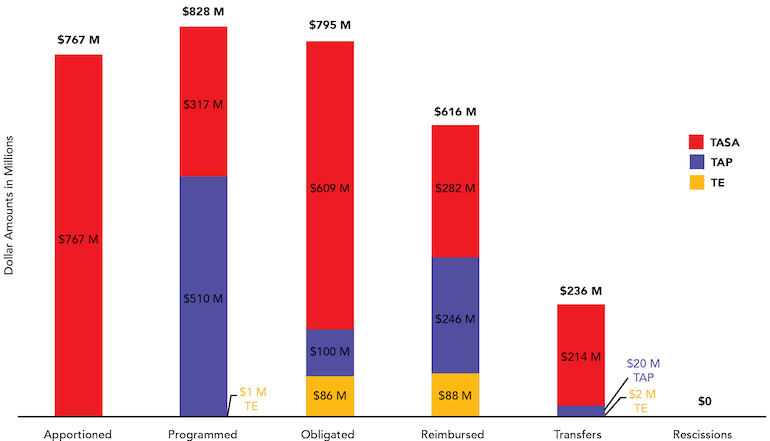Transportation Alternatives Spending Report Fiscal years 1992–2019


FY 2019 TrADE Report
Key findings of our FY 2019 report:
- 98% of TASA funds obligated in the last five years were used to fund trails, walking and biking
- Obligation rates reached 103.7% of available funds, or $795 million; states actively obligated remaining available funds from previous years
- 91% of TE/TA/TASA funds were reimbursed
- Approximately 30% of the total FY 2019 TA apportionment, or $241 million, was lost through lapsing and transfers
- This report supersedes all previously published editions
Executive Summary
The Transportation Alternatives Set-Aside (TASA) is the largest dedicated source of funding for trails, walking and biking in the United States. Since 1991, this program, formerly known as Transportation Enhancements (TE), has transformed the landscape of the country. Under the program, states have been able to make critical investments in building safe places to walk and bike. As a result, the United States now boasts more than 37,000 miles of multiuse trails, with communities reaping the long-known benefits. This infrastructure connects people to each other, creates economic vitality and promotes healthy outdoor mobility—saving money and decreasing roadway congestion, while reducing pollution and health care costs.1
Since the inception of dedicated Transportation Alternatives (TA) programs, Rails-to-Trails Conservancy (RTC) has monitored how these funds have been invested and the projects that have been built. This annual Transportation Alternatives Spending Report is an important tool for advocates, states and the active transportation movement at large to understand and strengthen the program—improving the efficiency and impact of the investments made.
The 2019 report found that 98% of the TASA funds obligated to projects in the last five years were used to fund trails, walking and biking. However, the national pipeline of potential projects needed to create connected active-transportation networks far exceeds the current level of funding and rate of obligation.
- Obligation rates reached 103.7% of available funds, or $795 million; states actively obligated remaining available funds from previous years.
- 91% of TE/TA/TASA funds were reimbursed.
- Approximately 30% of the total FY 2019 TA apportionment, or $241 million, was lost through lapsing and transfers; states lost $19 million to lapses in FY 2019, and $222 million was transferred out of the program, largely to the STP/ STBG and the Highway Safety Improvement Program, a trend that began under MAP-21 and continues under the Fixing America’s Surface Transportation (FAST) Act.
A Complex Era for Dedicated Funding
When Congress passed the Intermodal Surface Transportation Efficiency Act of 1991 (ISTEA), the legislation brought together roads, railroads, transit and other modes of transportation—including walking and biking—under one umbrella. Most notably, it established funding for TE activities that included building rail-trails and other facilities for walking and biking, improving main streets left behind by the interstates, preserving transportation history and mitigating environmental impacts of transportation.
ISTEA was an important development for trails, walking and biking; prior to the legislation, little was spent on walking and biking facilities. Using federal data, estimates indicate that from 1973 to 1991, a total of $40.7 million was spent on individual walking and biking projects that were not incidental to rebuilding a roadway. One year after ISTEA and the establishment of TE, $93.9 million was spent on the same types of projects.
TE continued to build America’s walking and biking infrastructure for the next two decades until, in July 2012, the Moving Ahead for Progress in the 21st Century Act (MAP-21) erased some of the gains that ISTEA had introduced. That reauthorization of federal transportation law consolidated several active transportation programs under the TA program, cutting its funding by a third, as compared with the investments made under TE. Most significantly, however, MAP-21 made it easier for states to transfer funds out of TA—a development that was further solidified by the most recent Fixing America’s Surface Transportation (FAST) Act legislation. Since MAP-21 was implemented, states have transferred $662 million out of TA in just seven years compared with $192 million that was transferred over the previous two decades (FY 1992–FY 2012).
The FAST Act, the bill that currently funds TASA programs, scheduled a rescission of unobligated funds for July 2020. The threat of losing unobligated balances caused many states to increase the rate at which they obligated funds for the 2019 fiscal year in order to reduce the balances from which the rescission amounts would be determined. While the rescission was ultimately repealed as part of a short-term funding bill in the fall of 2019, states must continue to obligate funds at a higher rate to ensure that TASA funds are used for their intended purposes.
Transportation Alternatives represents the single largest federal investment in trails and is among the smallest line items in surface transportation spending—the siphoning of funds away from the program paired with a reduced overall budget creates a funding loss that can be debilitating to states’ and communities’ plans for trails, walking and biking. This funding loss could encourage states to deprioritize the program, leaving unspent money on the table and discouraging additional federal funding. Furthermore, continuation of stagnant funding levels will continue to lessen the purchasing power and the impact of the program.
Spending Analysis
From 1992 through 2019, Congress apportioned $19.51 billion to the states for TE, TAP and TASA projects as shown in Figure 1. During that time, $3.02 billion was lost to rescissions, though the rescissions scheduled for 2018 and 2019 were repealed. The TrADE national project database shows that state departments of transportation (DOTs) have programmed a cumulative total of 36,204 TE/TAP/TASA projects from FY 1992 through FY 2019. (This does not include canceled projects or projects with no federal money.) A financial summary for FY 2019 follows in Figure 2.
The Federal-aid project funding cycle is successfully completed when federal dollars are dispersed to the project sponsor. Both the obligation and reimbursement rates are key performance measures for project implementation. The cumulative obligation rate for TE/TAP/TASA (FY 1992 to FY 2019) is 103.7%, which shows a strong commitment from states to pursue active transportation. The cumulative reimbursement rate for TE/TAP/TASA (FY 1992 to FY 2019) is 91% and indicates that TAP is treated as a priority in most states.

Lessons From FY 2019
The FAST Act, in its fourth year since implementation began in FY 2016, continues to see states using available remaining TAP funds from previous funding bills while concurrently using available TASA funds. The use of TE funds from bills prior to the introduction of MAP-21 in 2013 were minimally used for obligations and reimbursements as they continue to be phased out.
At the same time, in FY 2019, 27 states transferred $211 million in TAP/TASA to the Surface Transportation Program/Block Grant Program (STP/STBG) and the Highway Safety Improvement Program (HSIP)—which was about 27.5% of all funds apportioned that year. A key component of the FAST Act was a clause for the rescission of unobligated funds. The FHWA was scheduled to rescind (i.e., take back) unspent federal transportation dollars that had previously been allocated to states for active transportation, transit and highway infrastructure projects in July 2020. This resulted in several states increasing their programming of TASA funds to ensure the funding remained.

1 Torsha Bhattacharya, Ph.D.; Kevin Mills, J.D.; and Tiffany Mulally, Ph.D., Active Transportation Transforms America: The Case for Increased Public Investment in Walking and Biking Connectivity (Washington, D.C.: Rails-to-Trails Conservancy, 2019).

About TrADE
The Transportation Alternatives Data Exchange (TrADE) is operated by Rails-to-Trails Conservancy. TrADE helps stakeholders at the federal, state and local levels understand and implement the Transportation Alternatives Set-Aside (TASA) program. TASA provides funding from the federal government for projects that expand travel choice, strengthen the local economy, improve quality of life and protect the environment. Eligible projects include most activities historically funded as “Transportation Enhancements,” the Recreational Trails Program and the Safe Routes to School program. TrADE provides transparency, promotes best practices, and provides citizens, professionals and policymakers with information and access to funding data.
From 1996 to 2013, TrADE operated as the National Transportation Enhancements Clearinghouse, as a partnership between Rails-to-Trails Conservancy and the Federal Highway Administration.
For more information, visit https://www.railstotrails.org/policy/trade/.
Acknowledgments
This report was written and produced by Mary Ellen Koontz and Torsha Bhattacharya, reviewed by Kevin Mills, edited by Amy Kapp and Sharon Congdon, and designed by Joe LaCroix. Data collection, and table and figure production, were undertaken by Tiffany Mulally. The report was produced for the Transportation Alternatives Data Exchange (TrADE) at Rails-to-Trails Conservancy.
This publication would not be possible without the contributions of staff from state departments of transportation. The accuracy of the data they provide is crucial to the value of this report.

Donate
Everyone deserves access to safe ways to walk, bike, and be active outdoors.

